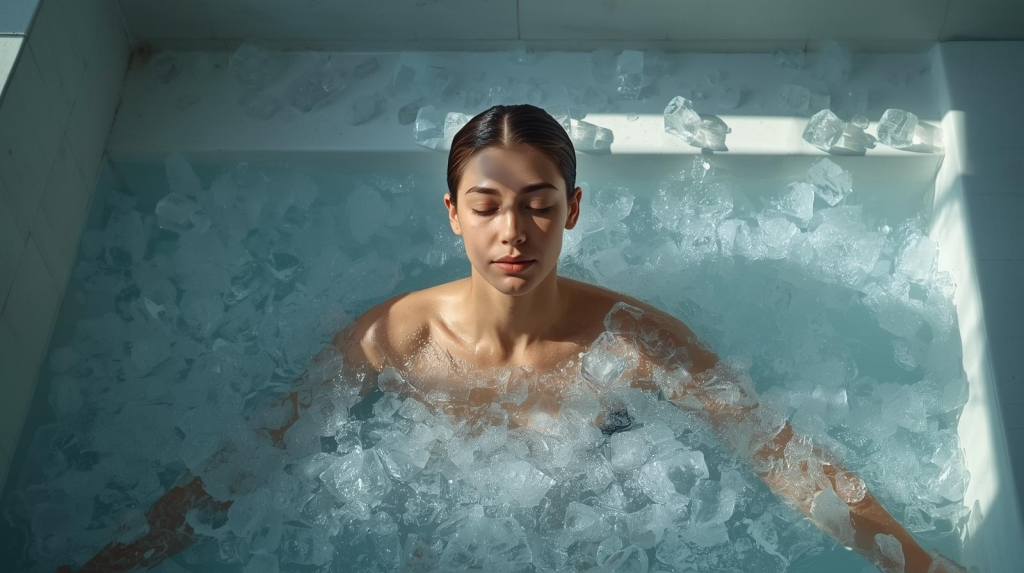Cold Plunges Make a Splash: The Science Behind the Shiver

It begins with a gasp. Step into ice bath and your chest tightens. Your breath quickens. Your brain screams get out. Yet millions are choosing to stay in plunging into tubs, lakes, and cryo chambers in search of energy and calm.
Cold plunging has gone mainstream. Once the domain of athletes and hardy northerners. This ritual now appears in gyms, backyards, and TikTok feeds. However, long before the craze, Stanford neuroscientist Dr. Andrew Huberman devoted a two-hour episode of his Huberman Lab Podcast to the science of what he calls “deliberate cold exposure.”
“Temperature is a very potent stimulus,” Huberman said. “Cold can reduce inflammation, enhance performance, and sharpen the mind.”
Why Your Brain Loves the Cold & An Ice Bath
Cold plunging jolts the nervous system. First, sensors in the skin send urgent signals to the brain. Almost instantly, adrenaline and norepinephrine spike, lifting energy and focus.
However, that’s only part of the story. Additionally, Huberman noted that cold immersion also raises dopamine — the brain’s motivation molecule — by 250 to 500 percent. Unlike the short buzz from coffee, this dopamine surge can last for hours.
“People talk about the post-plunge high,” Huberman said. “That’s real. It’s chemistry.”
Stress Training for the Nervous System Using an Ice Bath
Beyond mood benefits, Huberman believes cold is a tool for resilience. Each plunge forces the brain to remain calm while the body is under stress.
“Deliberate cold exposure is like lifting weights for your resilience,” he explained.
As a result, practitioners may get better at handling stress in everyday life. Whether that means a tough workout, a deadline at work, or even a family crisis.
Huberman’s Cold Plan
Unlike viral stunts, Huberman’s framework is practical, safe, and backed by studies. Here’s how it works:
Weekly dose: About 11 minutes total per week, spread over 2–4 sessions.
Temperature: Choose water that feels uncomfortably cold but safe. Even 60°F (15.5°C) works if you stay longer.
Duration: Start with short bouts. Then, increase gradually, or use the “urge-to-get-out” rule — stay a little longer each time you want to quit.
Timing: Morning or daytime plunges sharpen alertness. In contrast, late plunges can disrupt sleep.
After exercise: If muscle growth is the goal, skip plunges for 4 hours post-training. However, for recovery or endurance, immediate immersion is fine.
Fat-loss tweak: End cold, then allow shivering. This is because shiver burns calories and activates brown fat.
Timing Matters for An Ice Bath
Importantly, cold plunging interacts with the body’s natural circadian rhythm. Body temperature rises in the morning. It peaks in the afternoon, then falls at night to support sleep.
Therefore, a morning plunge reinforces wakefulness. But dunk yourself too close to bedtime and you may sabotage rest. “Cold is a tool,” Huberman said, “but tools have to be used at the right time.”
Where to Cool Off
Not all methods work equally well. Fortunately, Huberman ranked them clearly:
Best: Cold water immersion up to the neck, with hands and feet submerged.
Next best: Cold showers — easier but less studied.
Third option: Outdoor exposure with minimal clothing on a cold day.
Moreover, he noted that cooling the palms, soles, and upper face can quickly lower core body temperature. This makes them especially useful in hot environments or after hard exercise.
Beyond the Buzz
Cold exposure is more than a recovery tool. In fact, Huberman explained that it can also:
- Convert white fat (storage) into brown fat (calorie-burning)
- Speed muscle recovery by reducing inflammation
- Boost focus and cognitive control during demanding tasksF
In short, the science suggests cold plunges may improve both body and mind.
For those interested in pairing cold exposure with other lifestyle strategies. See our deep dive on intermittent fasting with Dr.Jason Fung.
Safety First
Despite the hype, Huberman warned that cold plunges are not risk-free. Indeed, they can be dangerous for people with heart conditions or other health issues. Shock, fainting, and hypothermia are real possibilities.
“This isn’t about masochism,” he said. “It’s about controlled stress, applied wisely.”
His advice is simple: progress gradually, know your limits, and seek medical guidance if in doubt.
From Niche to Normal
Three years ago, Huberman’s lecture sounded like a niche physiology lesson. Today, it reads like a manual for a booming wellness trend. Cold plunge studios are opening in cities worldwide. Meanwhile, social media is full of plungers posting their shivers.
Yet Huberman’s voice remains steady: no gimmicks, no icebergs, no bravado. Just consistency, caution, and respect for biology.
Or as he put it: “Find the minimum threshold that gives you maximum benefit.”

